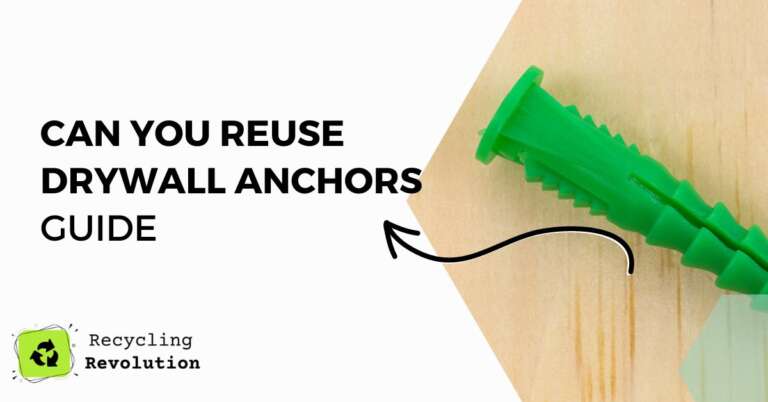Interior design isn’t always about the curtains or furniture you need to purchase for your home. Sometimes, it also requires a bit of craftsmanship, especially since the inside of the walls of your home are just as important as the outside.
Drywall anchors are a brilliant tool renovators use to anchor decorations such as houseplants, shelves and more.
Now, the big question is, are drywall anchors reusable or Can they also be recycled?
Read today’s guide for all the details.
Is it possible to reuse drywall anchors?
Whether a drywall anchor can be reused or not entirely depends on the type of product you buy.
While some drywall anchors are built for multiple uses, others can only be used once.
The thing about trying to reuse single-use drywall anchors is that they have lost their robustness, as the screw used to install them tends to weaken the plastic in the anchor.
And If, for any reason, you have to pull it out of the wall, you might end up damaging your wall or the drywall anchor completely, and we are sure you wouldn’t like that.
Some drywall anchors can be reused on the condition that the screw and anchor are carefully removed.
If you’re hellbent on reusing drywall anchors, please only invest in drywall anchors where the manufacturers explicitly state that they are removable and can be reused.
Trust us when we say this will save you a lot of hassle later.
Is it a good idea to reuse drywall anchors?
The minute you remove a used drywall anchor, the stretching caused by the screw tends to weaken the plastic.
Unfortunately, this makes it even harder to push the anchor into a new pilot hole without it collapsing under the weight of your hammer.
Nevertheless, if during the installation, you didn’t drive the screw too deep into the anchor, you can gently take out the screw and reuse the anchor somewhere else.
When removing drywall anchors, please ensure you use a plier and apply a gentle grip so you don’t end up ruining the anchor.
If you are careful and patient enough when removing the anchor, you’ll be able to reuse it.
But is it always a good idea to reuse drywall anchors?
To be honest, we don’t think it is a brilliant idea.
Just so you know, even if you’re able to save the drywall anchor and use it somewhere else, it won’t be as strong as when you first installed it.
Reusing drywall anchors and screws
Suppose you have already driven the screw into the wall anchor; there is every likelihood that you can reuse the anchor and screw.
To do this, you need first to loosen the screw.
This will expose some parts of the anchor.
Now, take your plier and gently pull out both the screw and the anchor.
Since the screw is still in the anchor, it tends to provide extra support for the plastic.
Finally, insert the anchor in a new pilot hole and screw it again.
When reusing drywall anchors and screws in a new pilot hole, please ensure the new pilot hole is slightly larger than the original one.
This provides a bit of solidity.
Does it make any sense to buy reusable anchors?
If you’re a sucker for reusable items and don’t mind reusing drywall anchors, there is absolutely nothing wrong with investing in reusable wall anchors.
The only issue is that finding reusable drywall anchors can be pretty challenging, as not every store has them on display.
More so, most people will prefer buying new drywall anchors to reusing an old one.
To get a good and reusable drywall anchor, take some time to check your local hardware store.
On the package, you should see a description that says that the anchors are reusable.
The unique thing about reusable drywall anchors is that they are designed to be sturdy, so they can be used multiple times.
The only caveat is that they cost a little more than regular drywall anchors.
Also, when shopping for a reusable drywall anchor, check the label for a description that says “removable.”
Can drywall anchors be recycled?
Unfortunately, because drywall anchors are small and made of plastic, recycling them can be pretty challenging.
Even if you eventually find a waste company that accepts plastic, they may not be willing to take the tiny pieces of plastic that drywall anchors have.
This is because most waste recycling companies only take plastics like yogurt containers or bigger ones.
Nevertheless, your local waste management companies or environmental groups can help find a recycling center that accepts plastic drywall anchors along with other items.
Are used drywall anchors biodegradable?
To be honest, drywall anchors aren’t biodegradable because most of the drywall anchors on the market are made from PVC plastics that are not easily broken down.
Sadly, this is something we have to deal with.
We hope things change in the near future.
Frequently asked question
Are drywall anchors useful?
When it comes to home renovation or remodeling, drywall anchors have proven to be quite useful as it makes it easy to attach things to the wall.
Also, using drywall anchors ensures that your shelves are held in place securely and safely.
Should I reuse drywall anchors?
Even though it’s possible to reuse drywall anchors, please ensure you invest in drywall anchors and screws designed for multiple uses.
By opting for reusable drywall anchors, you are sure that whatever you drill into the wall stays in place.
The cool thing about buying reusable drywall anchors is that it saves you money and a bunch of extra work.
How can I recycle my old drywall anchors?
As we mentioned earlier, recycling drywall anchors can be super challenging as most recycling companies don’t accept drywall anchors because of how tiny the plastics are.
Nevertheless, you can reach out to local environmental agencies to see if they can help you or advise you on what you can do.

